Carrots are the primary source of vitamin A in the American diet. Carrots are one of the most important vegetable crops in the United States. Carrot production in the USA is highly mechanized and highly concentrated. Carrots used for processing and fresh Carrots use mechanical harvesting techniques, and only two large California firms make up most of all Carrot products sold.
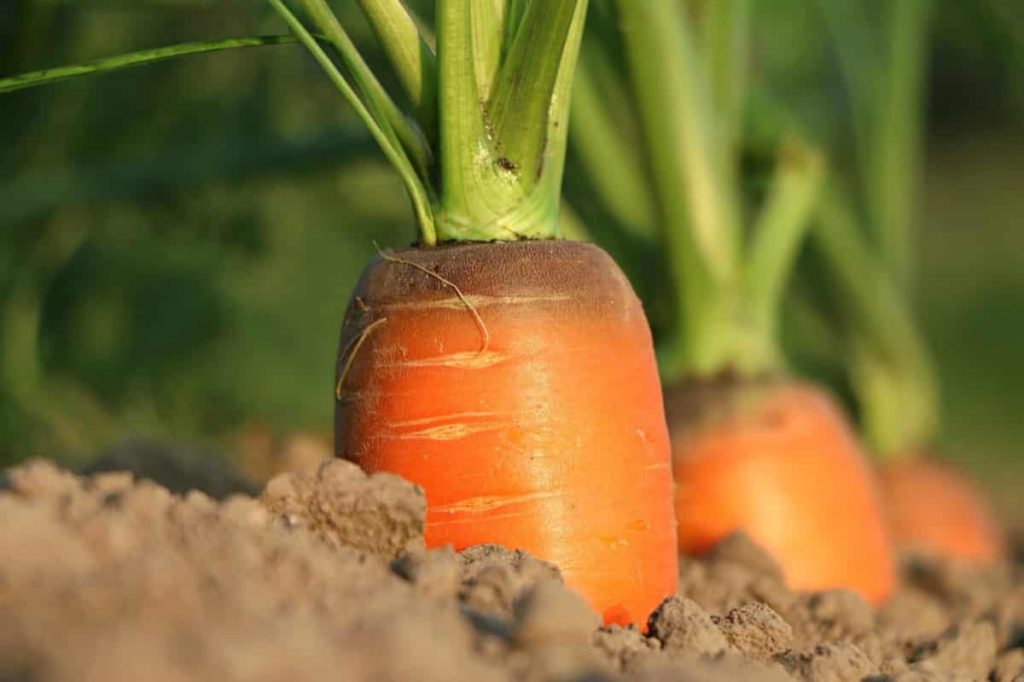
Carrots belong to the family Apiaceae, which includes celery, fennel, dill, and red pepper. It is a biennial crop that produces twins in the first year and, if left to grow, will flower, sow seeds, and die the next year. Most Carrots marketed in the USA are orange; other colors are red, yellow, or purple and can occasionally be found in fresh, frozen, and juice products.
How to start Carrot farming in the USA
Carrot-producing states in the USA
The top-producing states are California, Washington, and Wisconsin. Carrots grow in cold weather and can be planted early or late in the gardening season. Approximately 94% of US Carrot production is grown in seven states: California (66,580 acres or 63% of total production); Texas (9,400 acres), Washington (8,360 acres), Michigan (7,120 acres), Florida (6,780 acres), Colorado (3,700 acres) and Wisconsin (3,660 acres).
Which state is the largest producer of Carrots?
Carrots are grown and shipped year-round from California, with four major production areas. California produces more than 85% of all Carrots grown in the USA. Also, other major Carrot-producing states are Michigan and Texas. The production of fresh Carrots per acre was about 50,000 pounds. California produces about 85% of all Carrots grown in the United States. Colorado, Florida, Michigan, Texas, and Washington are the other major Carrot-growing states.
In case you missed it: Fertilizer Management in Carrot Farming: Organic, NPK, How and When to Apply
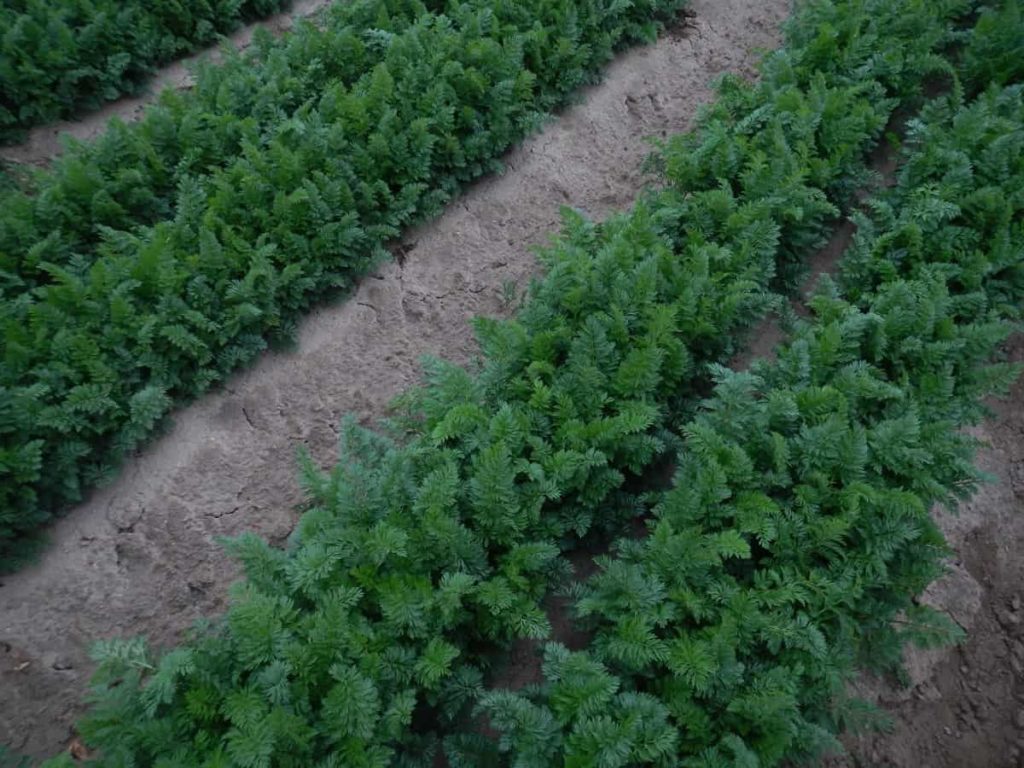
Soil requirements for Carrot farming in the USA
Carrots grow well on deep, loose, well-drained mineral and organic soils with good water-holding capacity. Most Michigan Carrots are grown on deep manure. Sandy and marl mixes can produce good Carrots but require more careful management. Sandy and clayey crusts easily after rain, which reduces seed germination and air intake. If crusting occurs, the soil between the rows should be worked with the cultivator as soon as possible.
Carrot roots are sensitive to soil compaction. Rows with wheel tracks often have more prickly and pruned Carrots in the middle of the bed than in rows, reducing usable yields. Therefore, limit the movement of equipment in the fields as much as possible. During the first three weeks of development, stay out of the field completely.
Carrot varieties available in the USA
Carrot varieties that perform best in Texas include Danvers 126, Danvers Half Long, Imperator 58, Nantes, Nantes Half Long, Red Core Chantenay, Royal Chantenay, Scarlet Nantes, and Sugar Snax. The Carrot is a biennial plant. During the season it is planted, the plant produces storage roots. After cold temperatures, the root grows again and produces seed stalks.
Most Carrot seeds are grown in areas of the western United States with a relatively mild cold. The seeds are sown in August and produce a small root before winter. The following spring, the plant grows again, and flowers and plant seeds are harvested in August. Most Carrots used in Michigan are hybrids.
There are four main types of Carrots;
- Imperator – long, short shoulder, tapered tip; mainly used for fresh packs. Most fresh Carrots grown in Michigan are of this type.
- Nantes – Medium length, uniform diameter, blunt tip; used for bunches, slicing, and small Carrots. Although not widely grown in Michigan, the Nantes-type Carrots have good food quality and are especially suitable for local sales. They usually mature before Imperator types.
- Denvers – Large, medium-long processing type used for dicing and slicing. Denver cultivation requires a long season (120 days) to produce tannins and high sugar content. Most Carrot varieties grown in Michigan for processing are of this type.
- Chantenay = Large shoulder, small, usually large, with clear color cover; Used for dicing. These older crops are not usually of the required quality for processors. They are now mainly used by home gardeners.
In case you missed it: Growing Baby Carrots – In Containers, Pots

Carrot varieties grown in the United States are biennial, requiring two full seasons from germination to seed production. However, it is grown commercially annually for its large storage root produced during the first year. There are real annual crop forms, but they are not grown in the United States. Young Carrots are tight rosettes with fine-grained leaves and a thin tap root with fine fibrous roots. As the taproot grows and matures, the conductive tissue becomes known as the light-colored core and the deep orange cortex.
Carrot season in the USA
Carrot season occurs between July and November in Colorado, Connecticut, Kentucky, Maine, Massachusetts, Minnesota, New York, North Dakota, Vermont, and Wyoming. But those interested in this vegetable can find it in Alabama, Arizona, Hawaii, California, Mississippi, Nevada, Texas, and Virginia in all four seasons.
Carrots are grown in California
Carrots are also shipped from California all year round, with the highest shipments from December to August. Carrots are mainly imported from Canada and Mexico. Across the state, California farmers grow about 62,000 acres of Carrots, with approximately one-quarter of it grown in the Imperial Valley. In recent years, Carrots have been ranked 17th in California’s top 20 livestock and crop commodities, valued at about ً $500 million, according to the US Department of Agriculture.
In southern San Joaquin and Cuyama Valleys, Carrots are planted from December to March for harvest from May to July and from July to September for harvest from November to February. In the southern desert, December to June is harvested from August to February. In the high deserts, it is planted from April to July for harvesting from August to December.
Cultural practices for Carrot farming in the USA
Although Carrots are often grown on sandy soils, they tolerate a wide variety of soils as long as the top 30 inches of soil is uniform and free of root growth. In some states, for example, Wisconsin, most production is on well-drained manure. In very heavy soils, the roots may be deformed and deformed. Soil suitable for Carrots has a pH of between 6.0 and 7.8.
Carrots are a cold-season crop, but they tolerate warm temperatures at the beginning of the growing season. The roots get the best color when the air temperature is 15 to 21°C. If the temperature is within this range three weeks before harvest, the roots’ color may darken rapidly, but at higher temperatures, the color may decline.
In case you missed it: Carrot Seed Germination, Time, Seed Sowing Method
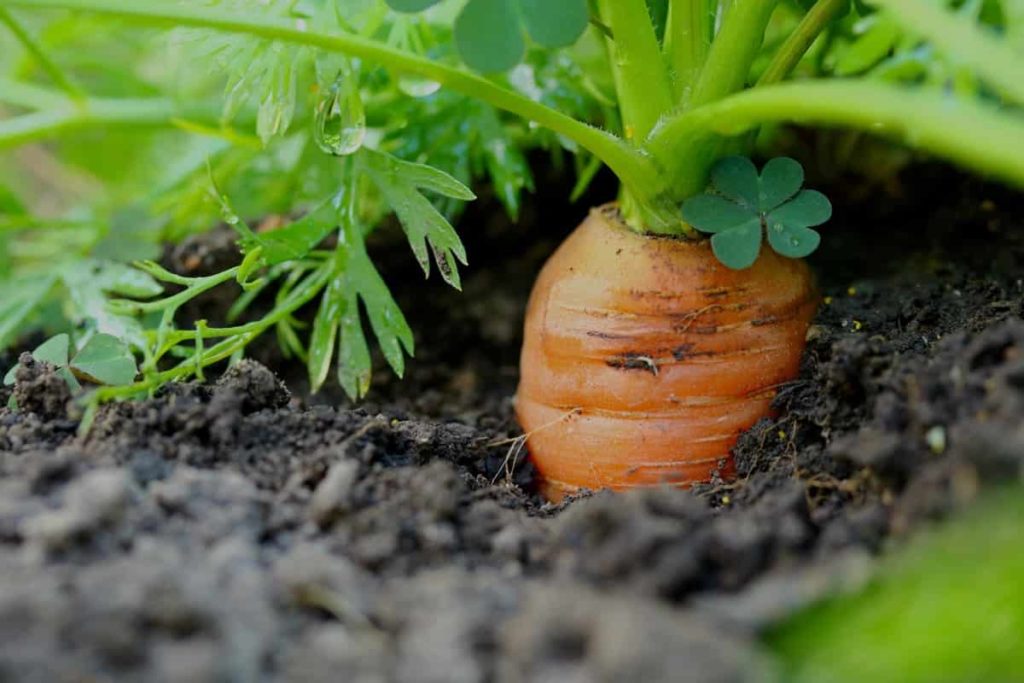
Carrots can withstand some frost. In California, Carrots are grown in 36- or 40-inch beds all year round. In the eastern states, Carrots are sown in spring row spacing of 12 to 36 inches. Carrots are always straight-seeded and never thin. Carrot seeds are smaller than other vegetable seeds, and germination is slower. Germination can take up to 10 days in cold weather.
Carrot seeds range from 175,000 to 400,000 per pound and are sown at up to 1,000,000 seeds per acre for fresh market varieties and low rates for large processing varieties. High densities of up to 1.2 million seeds per acre are often used in planting for the ‘cut and peel’ market. Seeds are usually sown in 6 or 8 rows per bed. Both natural and powdered seeds are used.
Planting process
Carrot planting dates will depend on temperature, type, time at which the farmer wishes to market the crop, and other factors. In most districts, except for the arid inland valleys of Arizona, California, and Texas, Carrots are planted in early spring because the soil can be worked on. Planting usually begins around April 15 and continues until mid-July. However, in California’s Salinas Valley, planting begins in January and continues through July.
Mid-winter and early spring crops are planted in the desert valleys from August 1 to October. Carrots are planted in February and March for the spring crop in Arizona’s Salt River Valley. Carrots require 65 to 75 days from planting to harvest, depending on the planting date. For some hybrid varieties, the time from planting to harvesting is much shorter than available pollen varieties.
Carrot seeds are smaller than other vegetables, and germination is slow and irregular. Young plants are small, weak, and fragile. They lack vigor until the first real leaves appear. For these reasons, planting techniques are very important. Poor planting can easily lead to stained stands, poor spacing, or other defects that result in poor yields of poor-quality roots.
Growing Carrots in containers
It is a great way to customize the perfect growing medium and avoid pests like Carrot flies. Pots must be at least 10 to 12 inches as deep and wide as possible. A great low-fertility mix is one part sand and one part potting mix. Sow very fine Carrot seeds on top of the filled pot and then cover them with just one touch of the mixture.
Water well, label, and set in a sunny position. Unlike Carrots on the ground, keep everything moist; these Carrots will be entirely up to you for all your needs. Thin the seedlings to a distance of one to two inches. Once they reached finger size, they harvested carefully.
Irrigation management
The first irrigation should be light and should be done immediately after sowing. Later irrigation is provided as required. Too much moisture causes small Carrots of light color and large diameter. The irrigation frequency depends on the soil type, weather, and type. Generally, an irrigated crop provides adequate moisture every 4-5 days in summer and every 10-15 days in winter. In the rainy season, only occasional irrigation is required. Water pressure should be avoided during root development to avoid root breakage.
Thinning
You will need to thin out your Carrot plants. Thinning provides enough space for Carrots to grow underground. When the Carrot leaves are two to three inches high (about 25 days old), they thin out the tender plants; they thin the plants so that the young plants are about two inches apart, depending on the variety of mature size. After that, apply a thin layer of organic mulch to help keep the soil moist.
In case you missed it: Carrot Farming Income; Cost; Profit; Project Report
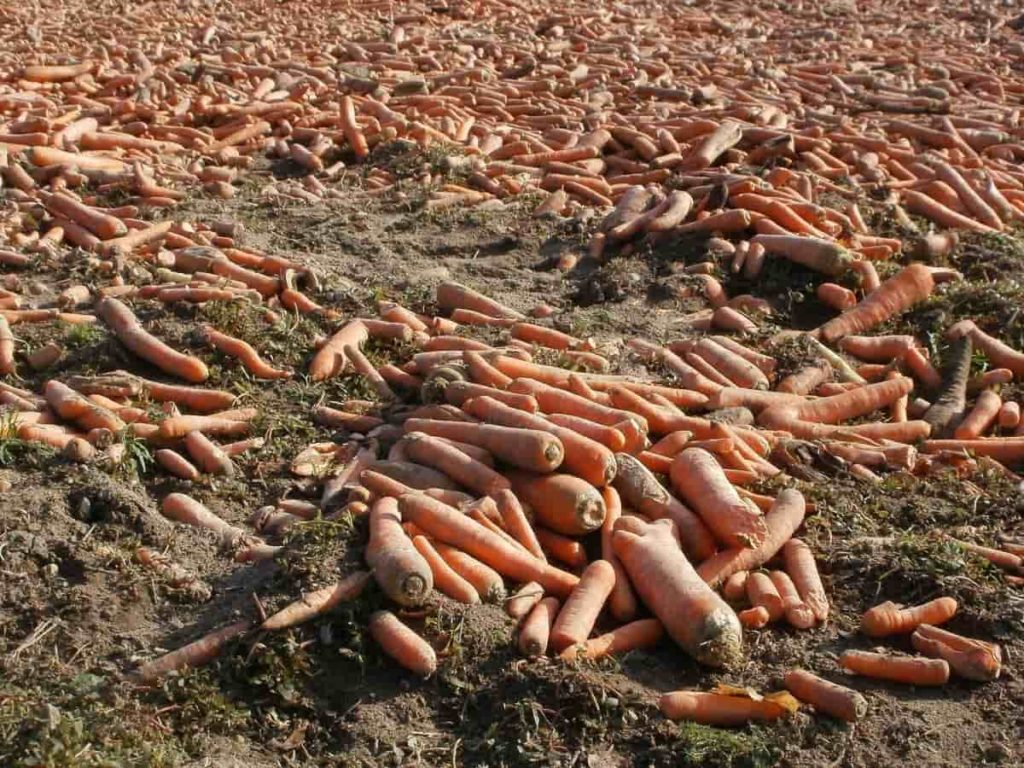
Carrot production cost per acre in the USA
Overall, 67% of US crops are destined for the fresh market, and 33% are processed. The production cost of fresh market Carrots, excluding land rental costs but including harvesting costs, ranges from $ 4,200 to $ 5,000 per acre; the processing cost of Carrots ranges from $ 1,500 to $ 2,000 per acre. Michigan grows about 7,000 acres of Carrots each year. The new market Carrots state production is about 8.8 tons of usable Carrots per acre.
Good fields can produce more than 15 tons per acre without nematodes, water, or other limited problems. Mini Carrots yield about 11 tons per acre. Processing Carrots can yield 35 to 40 tons per acre in good fields. Carrots are a cold-season crop that is always sown directly. The roots get the best color when the air temperature is 18 to 21ºC.
Although Carrots are available all year round, locally grown Carrots are available in summer and autumn when fresh and tasty. Carrots are grown and shipped year-round from California, with four major production areas. California produces more than 85% of all Carrots in the United States. Also, Michigan and Texas are major Carrot-producing states.
Quick tips on growing Carrots
When you grow Carrots, the soil surface should be cleaned of trash, rocks, and large pieces of bark. Fine pieces of plant material can be added to the soil for enrichment. Start with soil that will help Carrots grow. When you grow Carrots, the soil should be sandy loam. Make sure it is well-dried. Due to the heavy soil, Carrots ripen slowly, making the roots unpleasant and rough. Remember that when you grow Carrots, the soil should never be rocky as it can damage the roots.
How to plant Carrots from seeds
Carrots can be planted with nursery plants, but the common method is to sow the Carrot seeds in the garden directly as soon as the soil is viable in the spring. But Carrot seeds are small, which makes it difficult to plant them evenly. It can take up to three weeks for Carrots to grow. Ensure the soil is at least one foot deep, light, loose, and can drain well.
Make shallow skins in the soil (the long handle of the garden tool will work), 1/4 inch deep and one foot apart if you are planting more than one row of Carrots. Sprinkle small Carrot seeds two to three inches apart, 1/4 inch deep, and lightly cover with soil. Carrot seeds are difficult to place evenly, so you must thin them as they grow. Write the crop name and sowing date on a plastic row marker, paint stick, or popsicle stick to mark the location of your seed row.
To ensure good contact between the seeds and the soil, lightly press on the soil. Keep the skins moist and do not allow the soil to dry out as it will form a hard layer, which is difficult for small seedlings to break. Water the plants one inch a week. When the plants are one to two inches tall, thin them out and keep a distance of three inches; use tiny snips so that you do not pull the Carrot roots too close.
In case you missed it: Growing Carrots In Container Information
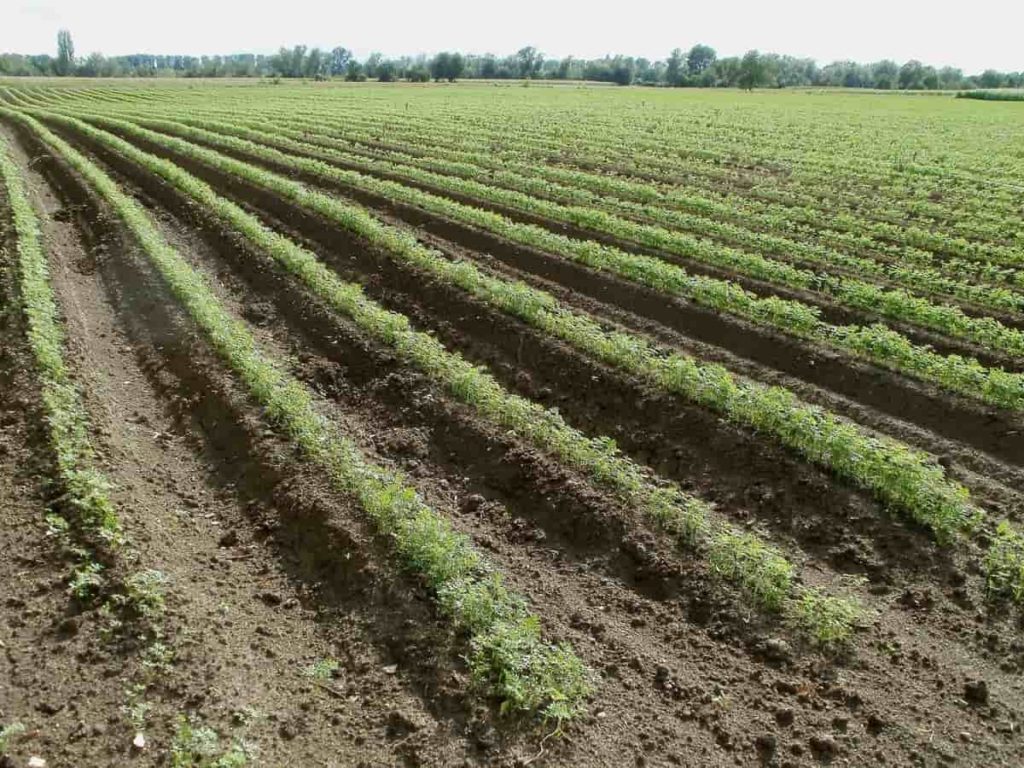
Problems for Carrot Farming in the USA
Wherever Carrots are grown, various diseases, insects, and weeds reduce root production and market value. Carrot bunches should have insect and damage-free tops as well as roots. Although tops are not a problem for large or lightly processed Carrots (e.g., cut and peel), a healthy crop is important because undercut Carrots from leaves are selected. The presence of heavy herbal infections also causes inadequate pruning.
Control of pests, diseases, and herbs is essential for good Carrot culture. Insects are usually minor Carrot insects, but insects in any field can cause severe economic damage. Across the country, the most important Carrot insects include leaf shoppers, aphids, cutworms, wireworms, Carrot weevils, armyworms, whiteflies, mites, and Carrot rust flies—flea beetles as the only major insects in California and Colorado.
Organic options include Bt-based pesticides and sulfur. Sulfur also has antifungal properties and helps control many diseases. Before using pesticides, read the label and always follow the precautions, warnings, and instructions. If leaf spots appear on plants, wash them with an approved fungicide. Remove any Carrot plants from the garden that turn yellow and stunt. If there are knots on the roots, you may have nematodes in the soil. Neem oil, sulfur, and other fungicides can control diseases. Always follow the label instructions.
Harvesting Tips for Carrots
Most varieties of Carrots take about 65 to 75 days, from seed sowing to harvesting. Grab the top of the Carrot when ready, then fold it in half and pull. Immediately cut off the green tops to prevent moisture loss. Rinse and store in refrigerator or other cool, dark place. Marketing Carrots are shipped from California all year round. California produces about 85% of all Carrots grown in the United States. Colorado, Florida, Michigan, Texas, and Washington are the other major Carrot-growing states. Carrots are mainly imported from Canada and Mexico.
Conclusion
Carrots are mainly fresh and the sixth most eaten fresh vegetables in the United States. Carrots are root vegetables; their leaves grow above the ground, and the edible Carrot roots grow below the ground. Both the root and the leaf are edible. The above growing conditions are useful for starting Carrot farming in the USA.
- Economical Aquaculture: A Guide to Low-Budget Fish Farming
- 15 Common Planting Errors That Can Doom Your Fruit Trees
- How to Make Houseplants Bushy: Effective Tips and Ideas
- Innovative Strategies for Boosting Coconut Pollination and Yield
- Pollination Strategies for Maximum Pumpkin Yield
- The Complete Guide to Chicken Fattening: Strategies for Maximum Growth
- Natural Solutions for Tulip Problems: 100% Effective Remedies for Leaf and Bulb-Related Issues
- Revolutionizing Citrus Preservation: Towards a Healthier, Greener Future
- Natural Solutions for Peony Leaf and Flower Problems: 100% Effective Remedies
- Maximizing Profits with Avocado Contract Farming in India: A Comprehensive Guide
- Natural Solutions for Hydrangea Problems: 100% Effective Remedies for Leaf and Flowers
- The Ultimate Guide to Choosing the Perfect Foliage Friend: Bringing Life Indoors
- From Sunlight to Sustainability: 15 Ways to Use Solar Technology in Agriculture
- The Ultimate Guide to Dong Tao Chicken: Exploring from History to Raising
- The Eco-Friendly Makeover: How to Convert Your Unused Swimming Pool into a Fish Pond
- Mastering the Art of Delaware Chicken Farming: Essentials for Healthy Backyard Flocks
- 20 Best Homemade Fertilizers for Money Plant: DIY Recipes and Application Methods
- How to Craft a Comprehensive Free-Range Chicken Farming Business Plan
- Brighten Your Flock: Raising Easter Egger Chickens for Beauty and Bounty
- How to Optimize Your Poultry Egg Farm Business Plan with These Strategies
- Subsidy for Spirulina Cultivation: How Indian Government Schemes Encouraging Spirulina Farmers
- Ultimate Guide to Raising Dominique Chickens: Breeding, Feeding, Egg-Production, and Care
- Mastering the Art of Raising Jersey Giant Chickens: Care, Feeding, and More
- Ultimate Guide to Raising Legbar Chickens: Breeding, Farming Practices, Diet, Egg-Production
- How to Raise Welsummer Chickens: A Comprehensive Guide for Beginners
- How to Protect Indoor Plants in Winter: A Comprehensive Guide
- Ultimate Guide to Grow Bag Gardening: Tips, Tricks, and Planting Ideas for Urban Gardeners
- Guide to Lotus Cultivation: How to Propagate, Plant, Grow, Care, Cost, and Profit
- Agriculture Drone Subsidy Scheme: Government Kisan Subsidy, License, and How to Apply Online
- Ultimate Guide to Raising Araucana Chickens: Breed Profile, Farming Economics, Diet, and Care
- Bringing Hydroponics to Classroom: Importance, Benefits of Learning for School Students
- Ultimate Guide to Raising Polish Chickens: Breed Profile, Farming Economics, Diet, and Care
- Ultimate Guide to Raising Australorp Chickens: Profile, Farming Economics, Egg Production, Diet, and Care
- Silkie Chicken Farming: Raising Practices, Varieties, Egg Production, Diet, and Care
- Sussex Chicken Farming: Raising Practices, Varieties, Egg Production, Diet and Care
- Homemade Feed Formulations for Livestock: Discover Cost-effective Starter to Finisher Feed Recipes